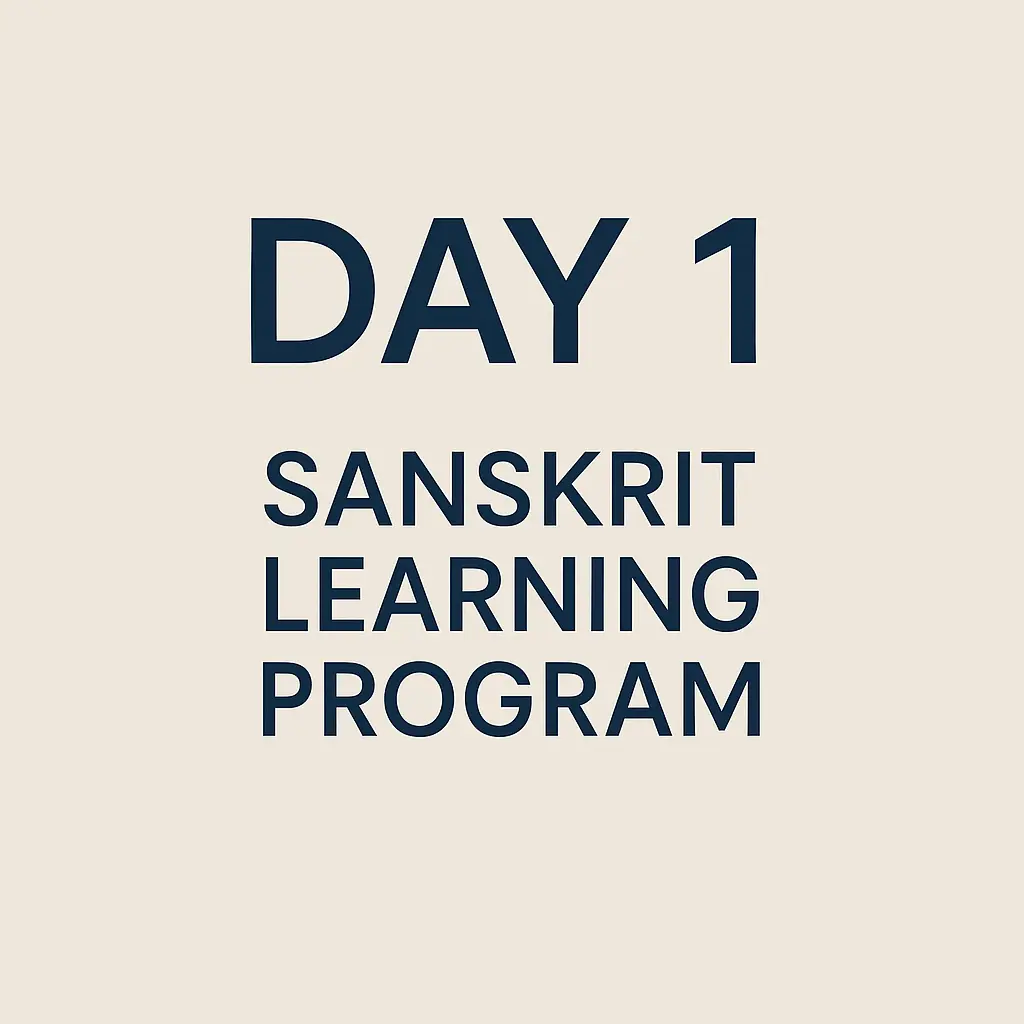Welcome to Day 1 of the ASPA Language Program your 30-day journey to mastering Sanskrit effortlessly.
Sanskrit is not just a language it is the art and soul of our ancient culture. It is one of the oldest languages in the world, and almost every modern Indian language has its roots in Sanskrit.
Learning Sanskrit is not only about reading old texts. It also trains your brain in a unique way. Your neurons activate differently when you learn Sanskrit improving memory, focus, and intelligence.
In short, learning Sanskrit makes you smarter, sharper, and more disciplined.
By understanding Sanskrit, you connect with our heritage, read ancient wisdom in its original form, and unlock a new way of thinking that enhances your cognitive abilities.
Why This 30-Day Program is Unique (ASPA Language Program)
In this program, you will learn Sanskrit step by step in Hindi and English just like sipping a daily cup of tea.
After 30 days, you will become a rare person with a fundamental knowledge of Sanskrit.
This program is:
- Designed under the guidance of Indian Sanskrit Peetha scholars
- Enriched with insights from Acharya students
- Crafted using the best language learning principles to make it practical, effective, and brain-friendly.
Even after just one week, you will notice improvements in your thinking, focus, and language comprehension.
Key: Stay curious, stay consistent, and make Sanskrit your daily habit.
How to Get the Most Benefit
1. Daily Journal Practice
- Write 1–2 sentences in Sanskrit every day.
- Treat it like a diary — note your thoughts or daily activities.
- Make your own small notes while learning. Your own handwriting strengthens memory.
2. Think in Sanskrit
- Form simple thoughts in Sanskrit.
Example: अहम् जलं पिबामि (I am drinking water). - Mental practice builds deeper brain connections.
3. Use What You Learn
- Speak, write, or translate simple sentences daily.
- Active usage makes the language natural and intuitive.
4. Stay Consistent and Curious
- Even 15–20 minutes a day is enough.
- Curiosity keeps learning enjoyable and effective.
Think of this program as sipping a daily cup of tea small, consistent efforts bring big results in 30 days.
Today’s Learning Objective
Today, you will learn:
- All Sanskrit vowels (Swaras)
- All Sanskrit consonants (Vyanjanas)
- Extra vowels & special sounds
- Compound consonants (Samyuktakshara)
- How to pronounce and write letters correctly
By the end of today, you’ll be able to read and write all basic Sanskrit letters and form your first simple sentences.
1. Swaras (Vowels — 13)
Vowels are the core sounds of Sanskrit. They are categorized into short vowels, long vowels, and compound vowels.
| Type | Letters | Pronunciation | Example (Sanskrit) | English Meaning |
|---|---|---|---|---|
| Short vowels | अ, इ, उ, ऋ | a, i, u, ri | अमृत (amṛta) | nectar |
| Long vowels | आ, ई, ऊ, ॠ | aa, ee, oo, rī | आग (āga) | fire |
| Compound vowels | ए, ऐ, ओ, औ | e, ai, o, au | ऐश्वर्य (aiśvarya) | wealth |
omplete Guide to Sanskrit Vowels (स्वर)
Learning Sanskrit starts with mastering the 13 vowels (स्वर).
Here’s a simple, easy-to-follow list with pronunciation, example word, sentence in Sanskrit, English translation, and explanation.
1. अ (a) – “uh” as in about
- Example Word: अग्नि (agni – fire)
- Sentence: अत्र अग्निः अस्ति।
- English Translation: There is fire here.
- Explanation: अ is the simplest vowel — soft and neutral. It forms the base of many words.
2. आ (ā) – “aa” as in father
- Example Word: आम्र (āmra – mango)
- Sentence: आम्रं मधुरं अस्ति।
- English Translation: The mango is sweet.
- Explanation: आ is the long form of अ, giving a long, open sound. Often used to express emphasis.
3. इ (i) – “i” as in bit
- Example Word: इन्दुः (induḥ – moon)
- Sentence: इन्दुः शोभते।
- English Translation: The moon shines.
- Explanation: इ is short and light. Frequently appears in names and simple words.
4. ई (ī) – “ee” as in see
- Example Word: ईशः (īśaḥ – Lord)
- Sentence: ईशः महान् अस्ति।
- English Translation: The Lord is great.
- Explanation: ई is the long form of इ — soft, clear, and melodious.
5. उ (u) – “u” as in put
- Example Word: उदक (udaka – water)
- Sentence: उदकं शीतलम् अस्ति।
- English Translation: The water is cool.
- Explanation: उ is short and rounded, often used in natural elements.
6. ऊ (ū) – “oo” as in food
- Example Word: ऊषः (ūṣaḥ – dawn)
- Sentence: ऊषः आगता।
- English Translation: The dawn has come.
- Explanation: ऊ is the long form of उ — gives length and softness to the sound.
7. ऋ (ṛ) – “ri” as in rig
- Example Word: ऋषिः (ṛṣiḥ – sage)
- Sentence: ऋषिः वनम् गच्छति।
- English Translation: The sage goes to the forest.
- Explanation: ऋ is a unique sound — a mix of vowel and consonant. Common in names and spiritual texts.
8. ॠ (ṝ) – long ṛ (rare)
- Example Word: — (rare in daily use)
- Sentence: ॠकारः विरलः अस्ति।
- English Translation: ṝ sound is rare.
- Explanation: Mostly appears in Vedic texts and chants.
9. ऌ (ḷ) – “lri” (very rare)
- Example Word: — (rare)
- Sentence: ऌकारः अपि विरलः।
- English Translation: ḷ sound is rare.
- Explanation: Only in ancient or Vedic words.
10. ॡ (ḹ) – long ḷ (very rare)
- Example Word: — (very rare)
- Sentence: ॡकारः दुरलभः।
- English Translation: ḹ sound is very rare.
- Explanation: Practically unused in modern Sanskrit.
11. ए (e) – “e” as in they
- Example Word: एकः (ekaḥ – one)
- Sentence: एकः बालकः अस्ति।
- English Translation: There is one boy.
- Explanation: ए is a long vowel — smooth, clear, and easy to pronounce.
12. ऐ (ai) – “ai” as in aisle
- Example Word: ऐश्वर्यं (aiśvaryaṁ – prosperity)
- Sentence: ऐश्वर्यं शुभम् अस्ति।
- English Translation: Prosperity is good.
- Explanation: ऐ is a diphthong — combination of अ + इ.
13. ओ (o) – “o” as in go
- Example Word: ओषधि (oṣadhi – herb)
- Sentence: ओषधिः उपयोगी अस्ति।
- English Translation: Herbs are useful.
- Explanation: ओ is clear, round, and smooth.
14. औ (au) – “ow” as in cow
- Example Word: औषधम् (auṣadham – medicine)
- Sentence: औषधं हितकरम् अस्ति।
- English Translation: Medicine is beneficial.
- Explanation: औ is a diphthong — combination of अ + उ.
Extra Vowels / Special Sounds
- अं — nasalized ‘a’, like um
- अः — visarga, soft ‘h’ sound
Practice Tip: Write each vowel 5 times aloud while pronouncing it.
2. Vyanjanas (Consonants — 33)
Consonants combine with vowels to form syllables and words. Sanskrit consonants are divided into five main groups plus semi-vowels and sibilants.
| Group | Letters | Pronunciation Example | Articulation Point |
|---|---|---|---|
| Ka-group (Velar) | क ख ग घ ङ | ka, kha, ga, gha, ṅa | Back of tongue touches soft palate |
| Cha-group (Palatal) | च छ ज झ ञ | ca, cha, ja, jha, ña | Middle of tongue touches hard palate |
| Ta-group (Retroflex) | ट ठ ड ढ ण | ṭa, ṭha, ḍa, ḍha, ṇa | Tongue curls back |
| Ta-group (Dental) | त थ द ध न | ta, tha, da, dha, na | Tip of tongue touches upper teeth |
| Pa-group (Labial) | प फ ब भ म | pa, pha, ba, bha, ma | Lips come together |
| Semi-vowels | य र ल व | ya, ra, la, va | Soft flowing consonants |
| Sibilants & Aspirate | श ष स ह | śa, ṣa, sa, ha | Hissing or breathy sounds |
3. Compound Consonants (Samyuktakshara)
| Sanskrit | Pronunciation | Example |
|---|---|---|
| क्ष | kṣa | Rakṣa |
| त्र | tra | Mantra |
| ज्ञ | jña | Gyana |
| श्र | śra | Shraddha |
| स्त्र | stra | — |
Mini Vocabulary (Daily Use)
| Sanskrit | Hindi | English |
|---|---|---|
| अहम् | मैं | I |
| त्वम् | तुम | You |
| पठति | पढ़ता/पढ़ती | Reads / Studies |
| गच्छति | जाता/जाती | Goes |
Example Sentences:
- अहम् पठामि — I study
- सः गच्छति — He goes
Daily Exercise / Challenge
Write all vowels, consonants, extra vowels, and compound letters 5 times each.
Speak each letter aloud while writing.
Write one simple sentence in Sanskrit:
अहम् विद्यालयं गच्छामि (I go to school).
Take your own small notes. Writing it yourself strengthens memory and helps your brain learn faster.
Motivation & Next Step
Congratulations! You’ve started your Sanskrit journey.
By practicing today’s letters and sentences, you’re building a strong foundation for reading, writing, and speaking Sanskrit.
Tomorrow: We will learn how to combine letters into simple words and sentences — your first step into real Sanskrit conversation.
One month of consistent practice will make you a rare person with fundamental knowledge of Sanskrit.
Join Our WhatsApp Channel
To avoid searching for the blog every day and get daily updates, exercises, and tips —
Join WhatsApp Channel





